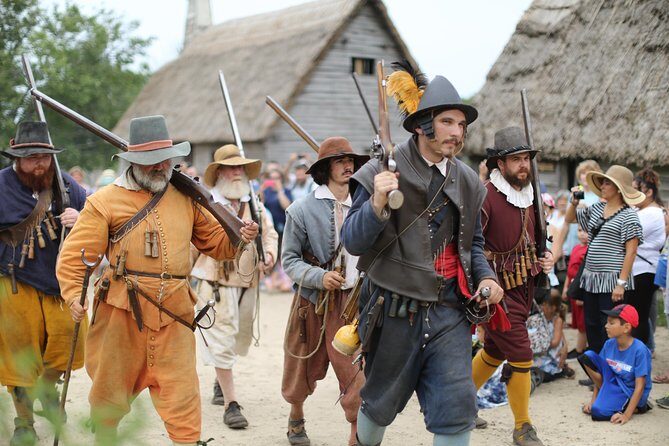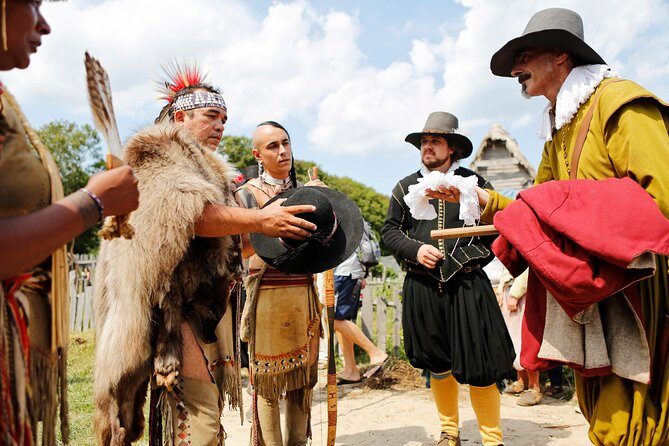Exploring the Past at Plimoth Patuxet Museums: A Hands-On Journey into Colonial America
If you’re looking for a meaningful outing that combines history, culture, and a touch of living storytelling, the Plimoth Patuxet Museums in Plymouth, Massachusetts, is a must-visit. For $35 per person, you get approximately four to five hours immersed in the story of the Pilgrims, Native Americans, and early settlers—especially appealing if you enjoy authentic reenactments and outdoor exhibits. The tour package includes access to the 17th-century English Village, the Patuxet Wampanoag Homeland, the historic Grist Mill, and the iconic Mayflower II, making it a comprehensive look at early American life.
What we love about this experience is how interactive and detailed the displays are—actors in period costumes bring the past alive, and the working Grist Mill offers a real sense of the daily survival skills of the colonists. Plus, the Mayflower II allows you to step aboard a faithful replica of the ship that carried the Pilgrims to Plymouth, a rare chance to walk in their footsteps.
A potential consideration is the duration—with so much to see, some visitors might feel pressed for time, especially if they want to explore everything thoroughly. Also, note that food and drinks are not included, so plan to bring snacks or plan for a meal afterward.
This tour suits history buffs, families, and anyone curious about the early American settlers and their relationships with Native Americans. If you enjoy engaging storytelling and outdoor exhibits, you’ll find plenty to love here.
Key Points
- Authentic Living Reenactments: Actors portray Pilgrims and Wampanoag in immersive settings.
- Diverse Sites: Visits include a historic Pilgrim village, native homeland, grist mill, and the Mayflower replica.
- Educational Focus: Interactive exhibits and guided interpretations enhance understanding.
- Value for Money: For $35, you get a well-rounded, multi-site experience.
- Accessibility: Free golf cart service available for those with mobility concerns.
- Weather-Resilient: Open in all weather, so dress appropriately and wear comfortable shoes.
An In-Depth Look at Plimoth Patuxet Museums

A Walk Through Living History in Plymouth
Once you arrive at the Plimoth Patuxet Museums, you’ll quickly notice the sense of stepping back 400 years. The experience isn’t just about looking at old objects behind glass, but actively seeing how the Pilgrims and Native Americans lived and worked. The 17th-Century English Village is a highlight, where actors in authentic costumes go about their daily routines, answering questions and sharing stories that make history come alive.
We loved the way guides and actors controlled the narrative—Kristine, one reviewer, called staff “super helpful,” and many pointed out how knowledgeable guides enriched their experience. You can ask questions, and the actors are trained to provide engaging, detailed answers, which makes the experience much more memorable than just reading plaques.
Planning more time in Plymouth? We've covered other experiences worth considering.
Exploring the Patuxet Wampanoag Homeland
A standout part of the tour is the Native Wampanoag village. Here, docents and tribal members share insights into Indigenous life before and after European contact. It’s a perspective often missing from traditional history tours, and many reviews highlight how knowledgeable and friendly the guides are. Rebecca_H emphasized that “the Wampanoag village was the best part,” describing the docents’ interesting stories about Native culture and history.
It’s worth noting that some visitors, like Jolene_M, mention that the focus is more on the native tribe than solely on Pilgrims—which is a valuable reminder of the complex history of this area.
Inside the Pilgrim Village: Daily Life on Display
Walking through the reconstructed houses, you’ll see early colonial homes, gardens, and craft centers. Actors portray Pilgrims engaged in tasks like cooking, farming, and crafts, giving a living snapshot of survival and community life. Scott_T noted that listening to actors in period costume added authenticity.
One of the most engaging aspects is the interactive storytelling—asking questions to actors often leads to fascinating insights. The village walk takes about three hours, according to reviews, giving plenty of time to absorb the details.
The Historic Grist Mill—A Functional Piece of History
A short walk from the Village, the Plimoth Grist Mill is a working reproduction of a 17th-century mill. Here, you’ll see how grain was processed into flour, a key part of colonial sustenance. The mill staff are eager to explain the STEM aspects of milling and how it supported the community’s survival.
Visitors like Melanie_R and Sasha_M were especially impressed with the knowledgeable staff and the authentic machinery. It’s not just a static display; you get to see the process in action, which brings the past to life in a visceral way.
The Mayflower II: A Floating Piece of History
A highlight for many is the Mayflower II, docked at Plymouth Harbor. Unlike the other exhibits, this is free to visit if you’re already at the site, and it offers a chance to walk the decks and imagine the voyage that carried the Pilgrims across the Atlantic in 1620. Visitors say it’s a must-see and a great way to connect physically with history.
- Half day Paddleboarding exploration on the Dart
- Guided walk on the remote and wild North Cornish coast
- Gun Range Shooting Experience in Newton Abbot
- 1.5-Hour Swanaford Vineyard Tour And Tasting Experience
- Plymouth Tour App, Hidden Gems Game and Big Britain Quiz (1 Day Pass) UK
- Shared Climbing Experience in Dartmoor
Practical Details and Visiting Tips
- Duration: Approximately 4-5 hours, depending on how much you explore.
- Cost: $35 per person offers good value considering the multiple sites and interactive elements.
- Transportation: The museum is about an hour south of Boston, and public transit is accessible. However, the Mayflower is 3 miles north at Pilgrim Memorial State Park, requiring a car or livery service.
- Accessibility: Free golf cart service is available, which is a real plus for those with mobility issues.
- Weather: The entire experience is outdoors or semi-outdoors, so dress for the weather and wear comfortable shoes.
Who Will Love This Tour?

This experience is perfect for families with kids, especially those who enjoy hands-on learning and reenactments. History buffs will appreciate the detailed storytelling and authentic reconstructions, while those interested in Native American culture will find the Wampanoag village particularly compelling. It’s also suitable for visitors who want a rundown of early Plymouth life in one convenient package.
If you’re pressed for time, you can choose to see just the Pilgrim village and the mill or include the Mayflower—though many reviews suggest doing the full tour for the best experience.
Final Thoughts

Plimoth Patuxet Museums offers a thoughtfully curated look at early colonial America by blending reenactments, hands-on exhibits, and historic architecture. It’s clear that the staff and guides are passionate about sharing history in an engaging way, making it much more than a static museum visit.
For history enthusiasts, families, or curious travelers, this tour provides not only educational content but also moments of genuine wonder and discovery. The combination of authentic costumes, working mill, and the iconic Mayflower makes this a memorable visit.
While it can be a full morning or afternoon outing, the experience’s depth and interactive nature make the price worth every penny. Just remember to plan ahead for transportation and weather, and prepare for an immersive step back in time.
FAQs
Is this tour suitable for children?
Yes. Many reviews mention that kids enjoy the opportunity to see actors in costume and explore the houses and gardens firsthand.
How long does each part of the tour take?
The Pilgrim village walk takes about 2.5 hours, the Grist Mill around 30 minutes, and the Mayflower visit roughly 30 minutes, though you can spend more or less time depending on your interest.
Can I visit just one site?
Yes. You can choose to visit either the Plimoth Plantation or the Grist Mill, or do the full tour with all three sites.
Is there transportation between sites?
The main museum is in Plymouth, about an hour from Boston. The Mayflower II is docked 3 miles north of the museum, so you will need a car or local transit to reach it.
Are food and drinks available on-site?
Not included in the tour price. You might want to bring snacks or plan to eat in Plymouth afterward.
Is the museum open in bad weather?
Yes. The entire site is open in all weather conditions, but dress appropriately, as much of it is outdoors.
In sum, Plimoth Patuxet Museums is a well-rounded, authentic trip into early American life—great for those who want a deeper understanding of the Pilgrims, Native Americans, and the everyday routines of 17th-century settlers. With plenty of opportunities for engaging storytelling and hands-on activities, it offers a compelling and educational experience that appeals to all ages seeking to connect with the past.
More Tour Reviews in Plymouth
More Plymouth experiences we've covered
- Day Tour of Plymouth and Cape Cod from Boston
- Self Guided Scavenger Hunt Plymouth Pilgrim Pursuit
- Lobstering Eco Tour
- Plymouth Harbor Party Cruise
- Plymouth Pilgrim Historic Self Guided GPS Audio Walking Tour
- Playful Plymouth, MA Scavenger Hunt
- Plymouth Pilgrims Self-Guided Walking Audio Tour
- What Are The Best Tours In Plymouth? Our Top 10 Picks
- 4 Must-Try Canoe & Kayak Experiences In Plymouth
- Shared Climbing Experience in Dartmoor
